
If you’re an ecommerce store owner, implementing inbound marketing strategies is essential. Grabbing prospective customers’ attention and enticing them to come to you is the most effective form of marketing.
According to Invespcro, well-executed inbound marketing is ten times more effective for lead conversion than outbound. It also produces 54% more leads and costs, on average, 61% less than outbound marketing.
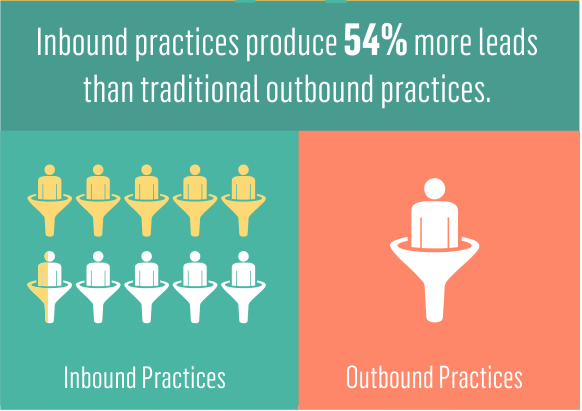
Source: Invespcro
If you’re not investing in inbound marketing strategies, you’re missing out on valuable opportunities to bring leads into your sales funnel. In this article, we’ll take a closer look at some of the inbound marketing strategies you should start using today.
But first, let’s define our terms.
What Is Inbound Marketing and Why Does it Work?
Inbound marketing is a business strategy that aims to attract leads to your business. The idea is that, through providing valuable content and experiences, you entice prospective buyers to come to you. Content marketing, social media marketing, branding, and SEO all fall under the umbrella of inbound marketing.
Inbound marketing works because it is centered on the customer experience. It consists of multiple channels and types of content, allowing your prospective buyers to engage with your store on their terms.
In outbound marketing, the sales process tends to go something like this:
- You make your prospect aware of your store, such as through a cold-calling campaign or trade show.
- You and your sales team supply product information.
- You assess whether the lead is qualified (i.e., likely to buy) or not, and market to them accordingly.
- The prospect decides whether or not to buy.
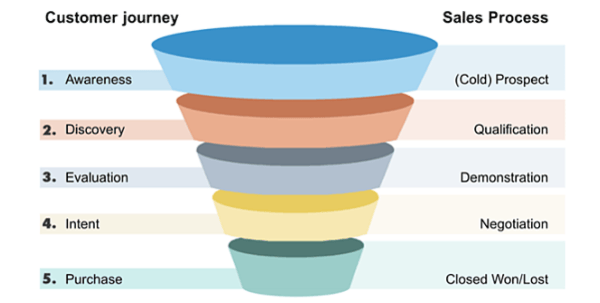
Source: Bristol
In other words, outbound marketing only offers one point of entry into your sales funnel and limited options for stewardship and engagement. With inbound marketing, however, there are multiple potential entry points to the funnel, and the customer can control their own experience.
The customer journey can be conceptualized as three main stages: awareness, consideration, and decision.

Source: Business2Community
In the awareness stage, you attract leads through valuable content and a great customer experience. Those who are sufficiently interested move to the consideration stage, and then to the decision stage. Here’s a breakdown of how it can look:
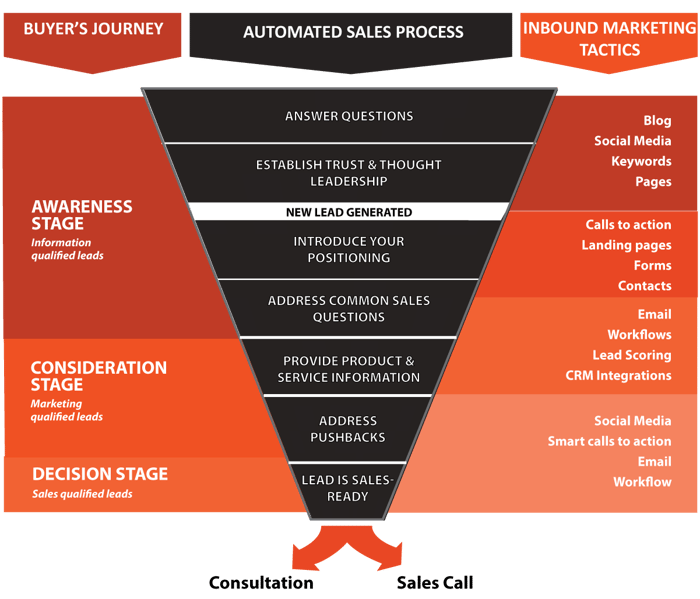
Source: Bristol
With inbound marketing, you empower prospective customers, building and nurturing the relationship to move them down the sales funnel to the conversion stage.
In the next section, we’ll look at some inbound marketing strategies you can start using straight away.
Inbound Marketing Strategies to Increase Your Sales
Now that you know what inbound marketing is and why it works, let’s explore some strategies you can use to attract new customers to your ecommerce store.
1. Blog, Blog, Blog
Why do you think people buy from established retailers like Amazon? The answer is simple: established authority. Fortunately, you don’t need Amazon’s reach or marketing budget to learn from its example. You just need to establish your authority in your niche. Enter blogging.
Blogging about relevant topics allows you to establish your expertise and attract potential customers. When people are looking for information, the internet is usually the first place they turn. The website that provides them with the information they need becomes a “knowledge center”. When a consumer trusts the content and information you provide, they’re far more likely to buy from you.
Let’s look at an example. Au Lit Fine Linens maintains an interesting blog. Though the blog includes product reviews and round-ups, most of the posts offer information on topics related to sleep:
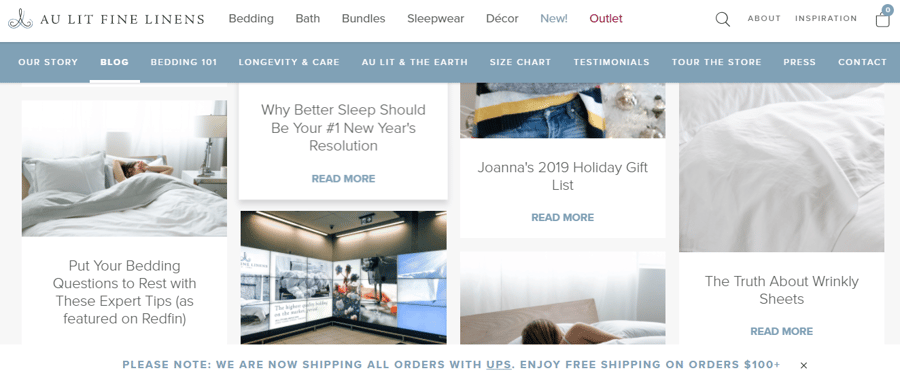
What topics related to your products can you blog about? For example, if you run a clothing store, you might blog about fashion and style. If you sell home office equipment, you might write about productivity and remote working. And so on.
The only way to attract people to your website is to provide value to them. The best way to provide that value is through original longform content that is well-written, well-researched, and addresses specific pain points. Mix it with attractive infographics to make it digestible. Combined, you’ll have yourself a digestible and shareable blog post for successful engagement.
Make sure you end every blog post with a call to action. This could be to sign up to your email list or buy a product or to contact you. To confirm that the call to action is working you should investing in analytics tools such as website analytics software, call tracking tools, and link tracking tools. You can use the data you collect to improve future blog posts.
2. Focus on SEO
Creating a blog won’t help if people can’t find it. Therefore, you need to ensure that the right people can find your content. This is where search engine optimization (SEO) comes in.
SEO refers to the things you do to help your website appear higher on search engine results pages. When people search for the keywords related to your business, you want to appear on the first page of the results.
According to SMA Marketing, 75% of users never click past the first page of search engine results. According to Moz, only 4% click on results on the second page, and only 1.6% on the third page. Therefore, SEO is essential.
Here are some simple SEO strategies you can start focusing on today:
- Focus on long-tail keywords. These are longer and more specific keywords and phrases as opposed to shorter or generic ones. Ensure your keyword appears in the title and several times throughout the post (but avoid keyword stuffing.)
- Optimize your images. Use a plugin such as WP Smush to optimize image sizes, and use alt tags featuring your chosen keywords.
- Make sure you use SEO-friendly hosting.
- Optimize your page speed to ensure the fastest possible load time.
- Write guest posts for sites with a high Domain Rating, with backlinks to your website.
By focusing on your SEO, you vastly increase the chances that the right people will find your content and store.
3. Put Social Media to Good Use
With billions of people on social media worldwide, it’s an essential marketing channel that cannot be ignored. 60% of consumers discover new products on Instagram, and 78% do so on Facebook.
While you do not have to be on every platform, you should maintain a presence on Facebook, LinkedIn, and Instagram at a minimum.
An active social media presence has several benefits:
- It provides another channel for new audiences to find you.
- It can boost your SEO. Maintaining social media accounts is considered an off-page SEO strategy that helps improve your rankings.
- It allows you to engage with existing customers and cultivate relationships with those in the “consideration” stage.
- Increasingly, the major social media platforms are rolling out in-app purchasing. This means that people don’t even need to visit your website to buy from you, which ups the potential for impulse purchases.
To use social media to its full effect, you must have a strong understanding of your target audience. Who are you trying to appeal to? How do they think, how do they talk, and what’s important to them?
Here’s an example from clothing retailer Forever 21, which uses slang and emojis to appeal to its young audience:
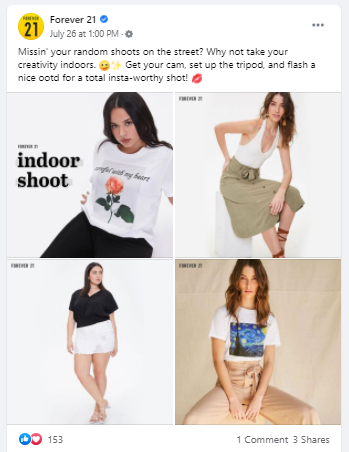
Sharing your products is one good way to use your social media channels, but this shouldn’t make up the bulk of your content. Instead, provide value to your audience and give them opportunities to engage. Ask questions, share your blog posts, link to other relevant content, and share tips and tricks. Be consistent by maintaining a content calendar and scheduling all your Instagram posts in advance. Don’t forget the power of visual and video content in your social media posts, too.
Here’s an example from BioLite, an ecommerce store selling outdoor energy gear:

The teaser video entices people to click through to the blog post. Once they’re on the site, they are more likely to browse products and possibly make a purchase. Even if they don’t buy there and then, BioLite will come to mind the next time they’re in the market for a product it sells.
4. Retarget your Audience
If a visitor leaves your site without making a purchase, you haven’t necessarily lost them forever! However, it takes some effort to ensure they return and eventually buy. One of the best ways to keep visitors coming back to your site is to do a retargeting campaign.
Have you ever visited an ecommerce store and not made a purchase, then spotted a display ad or social media ad for that store’s products shortly afterward? If so, you’ve been retargeted! Here’s an example of a retargeted ad from travel industry giant, Expedia:

You can retarget customers based on website visits, views of specific products, abandoned shopping carts, or even past purchases. A retargeting campaign reminds them why they were interested in your products and nudges them towards completing their purchase.
According to Criteo, 43% of website visitors who are retargeted convert. That’s an impressive figure, considering that 97% of first-time website visitors do not make a purchase. It takes several visits for the average visitor to become a customer, so keep them coming back with retargeted ads.
You can do retargeting campaigns with many platforms, including Facebook, Google Ads, LinkedIn, YouTube, and Instagram. You just need to add a small piece of code called a tracking pixel to the relevant pages on your website. Set up your ad, choose your audience parameters and budget, and you’re good to go!
One particularly effective way to use retargeted advertising is to offer a limited-time sale or promotion. Creating a sense of urgency encourages Fear of Missing Out (FOMO) and drives conversions. Here’s an example from clothing retailer J. Crew:
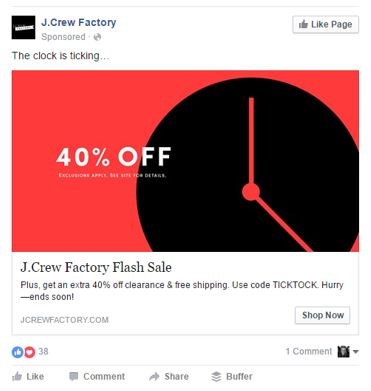
5. Offer an Incentive or Discount
Everyone loves a discount or special offer. That’s why offering incentives is one of the most common inbound marketing strategies for ecommerce businesses. Have you ever visited an ecommerce website for the first time and been offered a 10% discount on your first purchase? This kind of incentive for new customers is popular for one reason: because it works!
Make sure you display the incentive prominently on your homepage, landing page, and relevant product pages. Here’s an example from clothing retailer POM London:
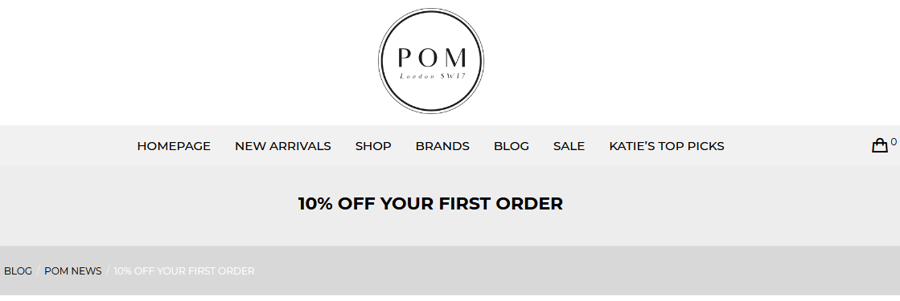
A survey from RetailMeNot on Inc.com found that two-thirds of consumers have “made a purchase they weren’t originally planning to make solely based on finding a coupon or discount”. The same survey found that an astounding 80% feel encouraged to make a purchase with a brand that is new to them if offered a discount or incentive.
6. Host a Giveaway
Contests and giveaways are fantastic inbound marketing strategies. The idea is simple: entice consumers to your website with an opportunity to win a prize.
The people who will visit your site and give their details to enter a contest are the people who are interested in your products. Since you’ll need their email address to notify them if they win, a contest is also a brilliant way to get new prospective customers onto your email marketing list.
Here’s an example from Eli Constant Books, which hosted a Walking Dead Super Fan Giveaway:

Source: Sumo
Of course, your prize must be related to what you’re selling. A highly anticipated new product, a themed bundle of items (as in the example above), or a gift card for your store are all great options.
7. Use Drip Campaigns to Nurture Leads
As we’ve discussed, most customers will not make a purchase the first time they learn about your store. Therefore, once you’ve enticed them in with your fantastic content or amazing social media channels, you need to keep them interested and engaged.
That’s where email marketing comes into play.
Marketing emails are not hard sells and do not exist solely to promote your products. Instead, they should provide value to the recipient at every stage, building the relationship and earning their trust.
Email marketing drip campaigns are one of the best ways to do this. A specific action will trigger each sequence, and the first will usually be triggered when the visitor signs up to your email marketing list.
Here’s an example of a simple email sequence from White Flower Farm, a plants and gardening supplies retailer:
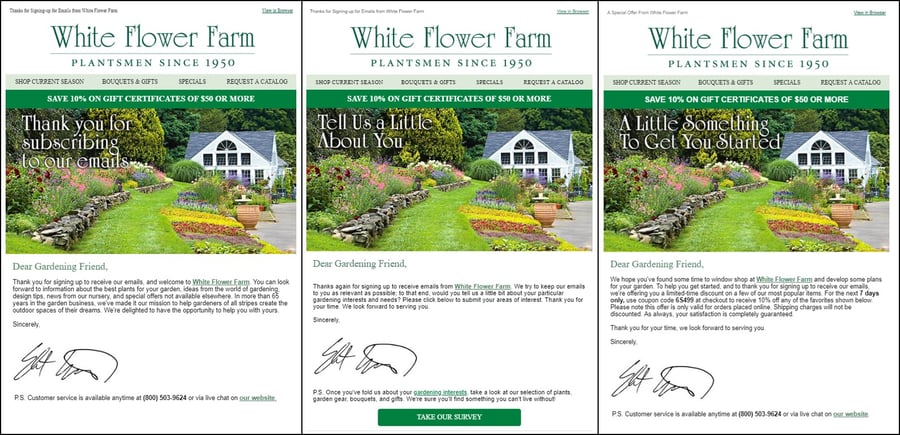
Source: Constant Contact
You can use a similar structure for your initial campaign. Here’s a breakdown:
- Email Number 1: The “Thank you for subscribing” email. At this stage, you are simply welcoming the customer aboard. If you offered a lead magnet to encourage them to sign up, such as a freebie or bonus, this is where you deliver on that promise.
- Email Number 2: The “Tell us about yourself” email. At this stage, you might use a quiz or questionnaire to learn more about the customer’s product needs and preferences.
- Email Number 3: The sales email. This should take a gentle approach, not a hard sell. You might wish to offer a limited time discount at this stage.
Another typical email marketing drip campaign is the abandoned cart sequence. Here’s an example from clothing retailer Zulily:
Moosend found that over 50% of cart abandonment emails are opened. Out of these opened emails, 21% clicked through, and the click-to-conversion rate was 50%. Billions of dollars of transactions are lost every year due to abandoned carts. Therefore, it’s well worth trying to recapture those who put items in their cart but didn’t complete the purchase!
There are many other drip campaigns you can run. Here are just a few possibilities to consider:
- If a recipient has stopped opening your emails, run a re-engagement campaign.
- Run a “welcome patrons” campaign for new customers who have just made their first purchase.
- Seasonal campaigns, such as Christmas and Black Friday.
Email marketing is one of the most effective of all marketing channels, with an average ROI of $38 for every $1 spent.
Wrapping Up
Inbound marketing is essential for ecommerce store owners who want to attract more leads, engage more effectively with their audience, and ultimately increase sales.
Inbound marketing works because it makes the customer feel valued and involved. It is more like a conversation, rather than them feeling talked at. Inbound marketing respects your audience members’ agency, leading them to make their own decision to buy from you, rather than telling them what to do.
Don’t panic – you don’t have to try all the strategies on this list at once! If you’re new to inbound marketing, choose just one or two at first. Once you get the hang of them, you can expand and scale your marketing efforts.
Keep at it, and your ecommerce business will be booming in no time. Good luck!





Leave a reply or comment below